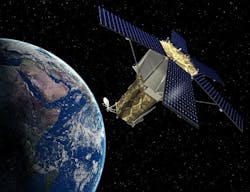Hosted payloads are a necessity to save money, combat threats, says U.S. Air Force SMC Col. Beidleman
LONG BEACH, Calif., 5 April 2014. Hosted payloads are a necessity, affirms Colonel Scott Beidleman, director, development planning, Space and Missile Systems Center (SMC), U.S. Air Force, during the Space Tech Conference in Long Beach, Calif.
Hosted payloads are a necessity, Beidleman says, for two reasons: one is budget, which requires innovative and affordable ideas, and the other is threat, given that space is congested and contested. “It is sobering the number of countries that are growing their capabilities” in space and the ability to block others access to information. That number is 15 and growing, according to aerospace industry pundits.
“Decreasing budget and increasing threat drives policy to pursue more affordable and resilient solutions,” reads both the National Space Policy (July 2010) and National Security Space Strategy (Jan. 2011).
Among the key benefits of hosted payloads is the ability for faster technology refresh—“the opportunity to get new technology payloads in space faster,” Beidleman adds.
Commercial hosting is a viable opportunity, Beidleman explains, and one that U.S. Air Force officials plan to implement.
The U.S. Air Force’s Hosted Payload Solutions (HoPS) initiative is aimed at leveraging commercial satellites for some government missions. HoPS will provide the Air Force Space and Missile Systems Center (SMC) and other U.S. government organizations with “a capability for hosting Government payloads on commercial spacecraft to meet mission objectives,” officials say. The HoPS contract will procure a fully functioning on-orbit hosted payload system and integrated ground system equipment and interfaces that deliver payload data to the government end user. SMC’s Developmental Planning Directorate is the acquisition office for HoPS.
U.S. Air Force Space and Missile Systems Center (SMC) officials also hope to resurrect the previously cancelled Commercially Hosted Infrared Payload (CHIRP) program by launching a sensor-based payload on a commercial satellite in 2016. The CHIRP hosted payload mission incorporates a missile warning sensor on a communications satellite (comsat) and costs roughly $200 million.
Beidleman is seeing a paradigm shift whereby engineers are baking in payloads—including military satellite communications, defense weather systems, infrared space systems—from the start; baked-in payloads are included in the satellite or other spacecraft’s design phase, rather than as an add-on after design, development, manufacturing, and assembly. Officials are “vetting hosted payloads in some of the families we are considering, and it is baked in from the start,” he adds. “We are talking to everyone in the government who might benefit from this—other federal government agencies, international governments, hosted payload industry partners, etc. We are not just saying we are going to do this, we are doing this.”


